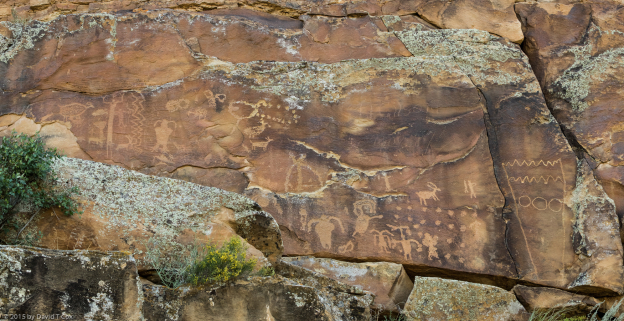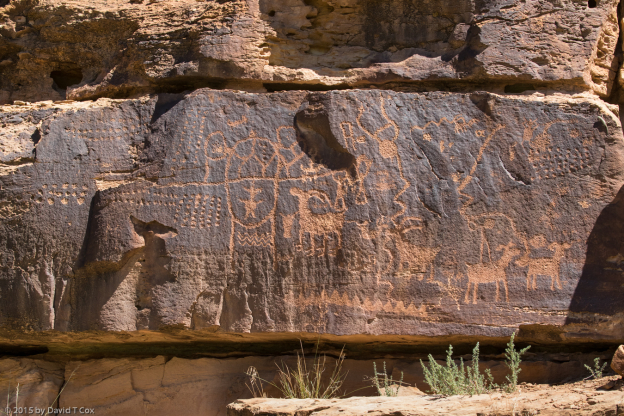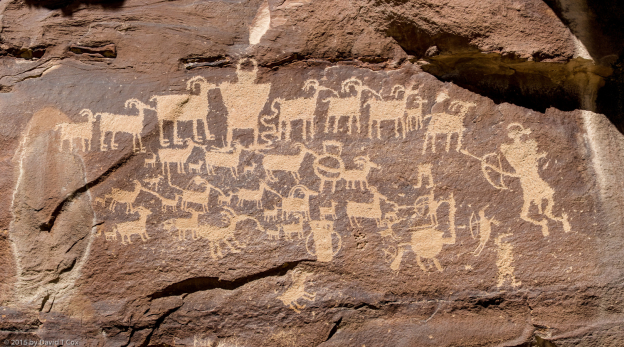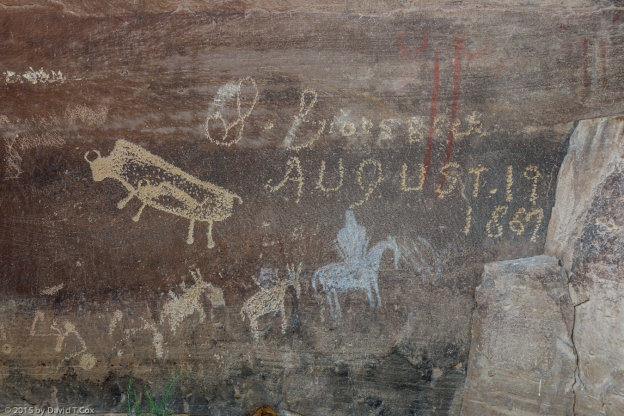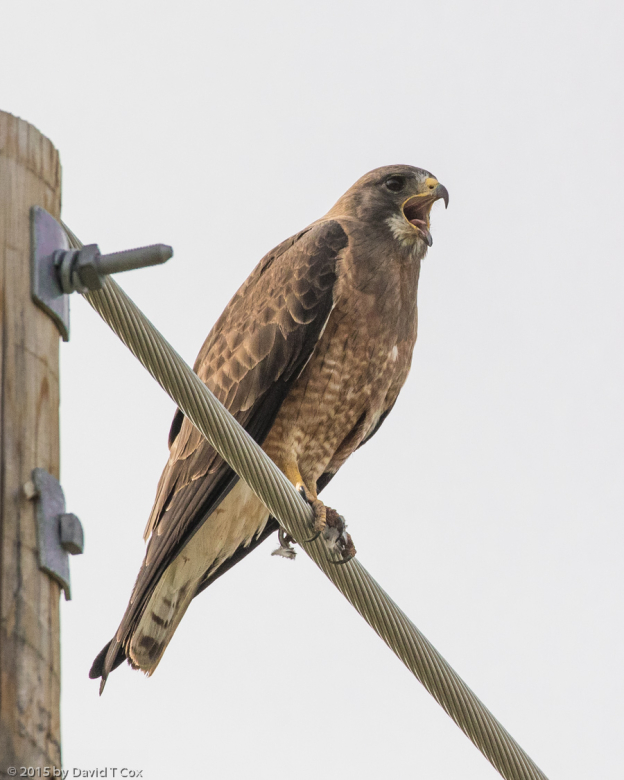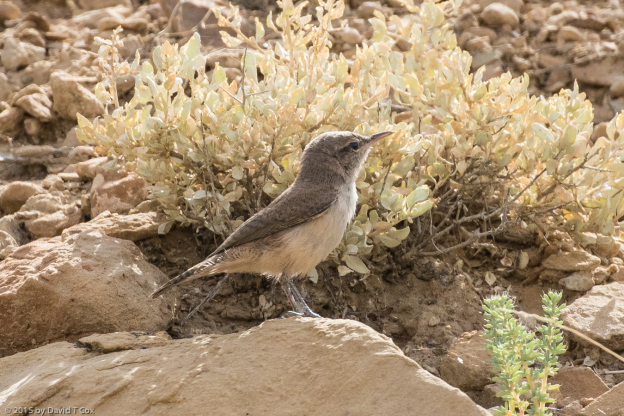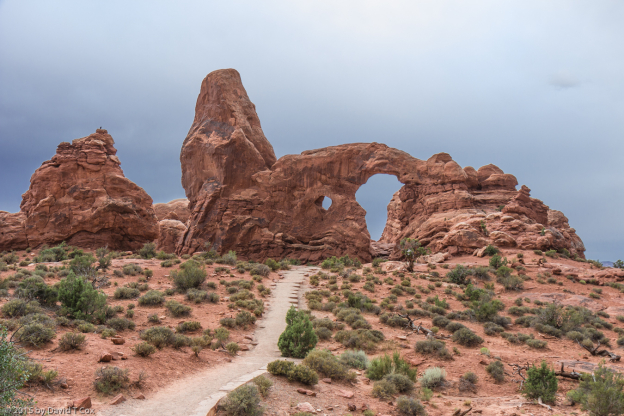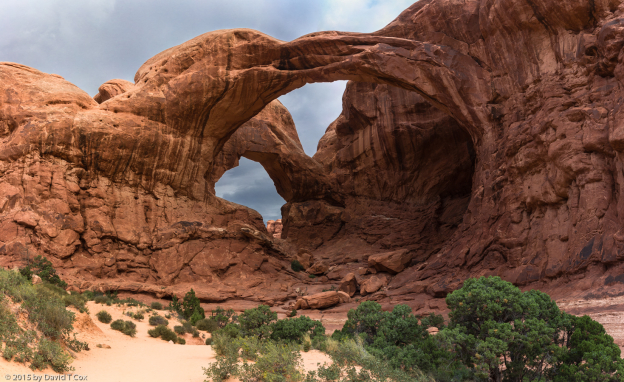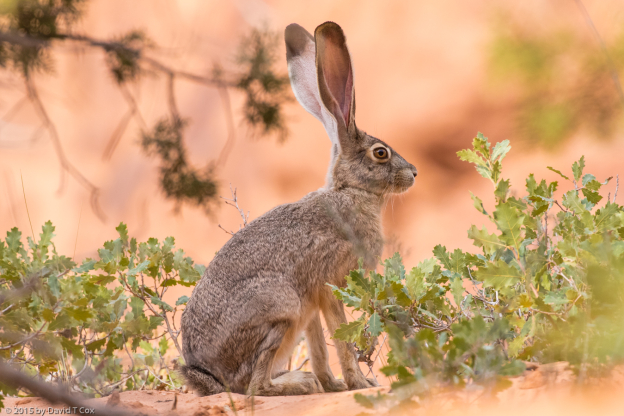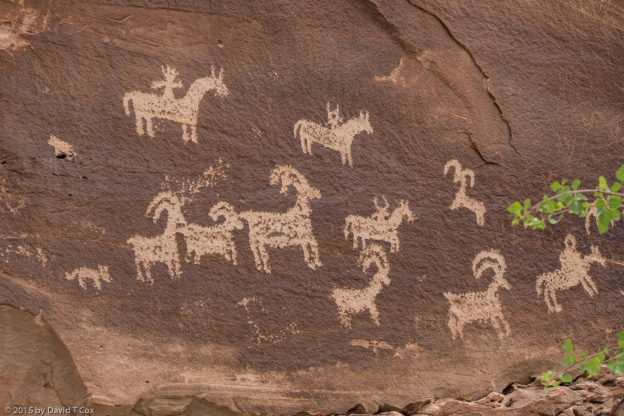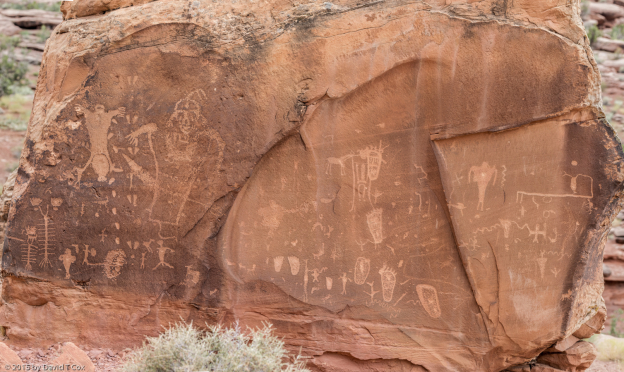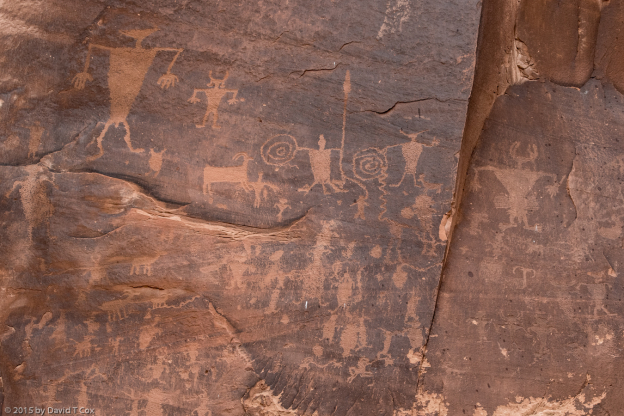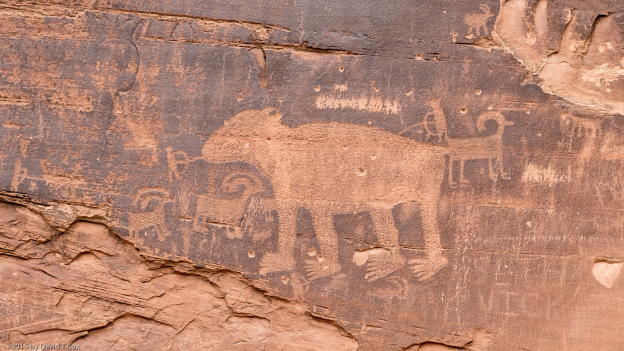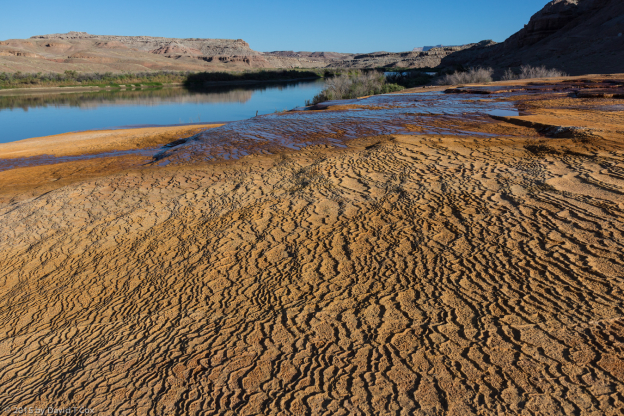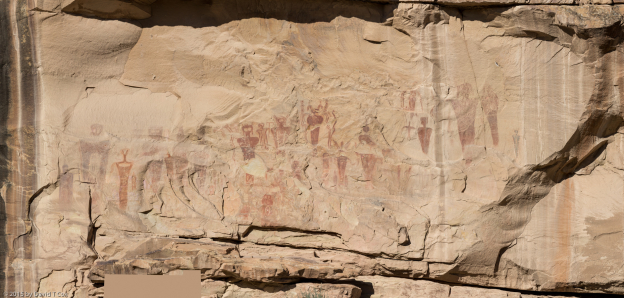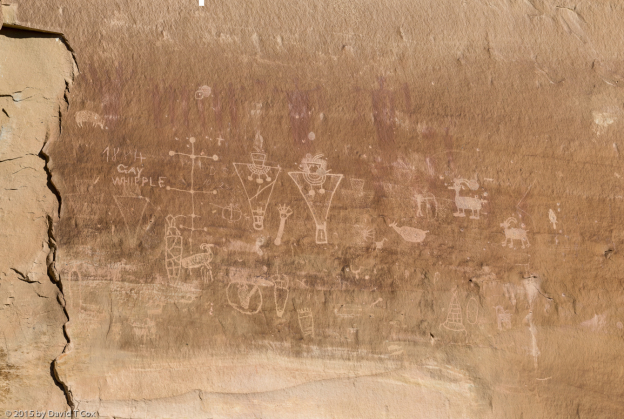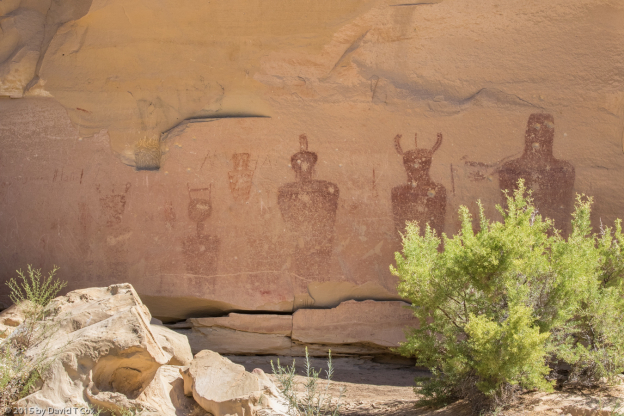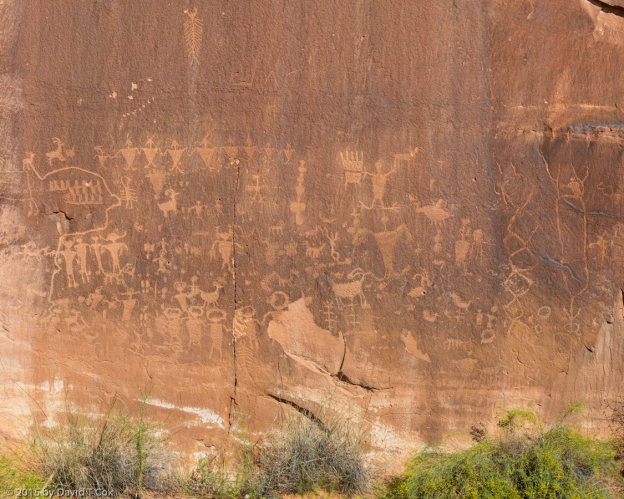All Photos Are Below the Travelogue Text
Click on Any Photo To Open Slide Show
To print the travelogue, right click anywhere on the page. Choose "Print" from your browser dialog box. You can choose Save to PDF in the browser print window.
Share your thoughts.
Email Dave - coxdavid55@hotmail.com
Hello again. Almost 2 weeks ago I left Montrose Colorado and drove to Green River, Utah, a small western town off of Interstate 70 which straddles the Green River (the Green River, which originates in Wyoming, is not only the major tributary of the Colorado River, but actually is longer than the Colorado segment, and drains a larger basin, and by traditional naming conventions should be the name of the river running through the Grand Canyon). Green River (the town) sits at the epicenter of the Barrier Canyon style rock art pictographs, as well as the Fremont culture petroglyph style. I found a little RV park just recently reopened and trying to get on its feet, so giving me some privacy as well as cheap rates, along with ok facilities and Wi-Fi. One really good restaurant in town, and it is always crowded – the Tamarisk, right overlooking the river, is a delight, with a great all-you-can-eat salad and soup bar. I always eat almost exclusively here when in Green River.
On Tuesday I spent almost 10 hours driving up to and through the “9-Mile Canyon” – a misnomer as the canyon system actually is over 45 miles long (it is named for an original survey done over a 9 mile radius). The latter 25 miles of the canyon, as well as side canyons, are filled with Fremont petroglyph panels, quite a few of amazing quality. Many of the canyon shelves and ridges have evidence of Fremont pit houses and granaries. The most famous of the petroglyph panels is called the “Great Hunt”, and shows bighorn sheep together with men with bows and arrows, with a classic Fremont trapezoid anthropomorphic figure. Another well known panel is called the “Big Buffalo,” with its nearby companion called “Pregnant Buffalo”. Upon inspection of my photos I am fairly convinced the buffalo panels are not of Fremont origin, but rather historic, made in 1867 by the person who left his signed graffiti on one panel.
Thursday I drove up the Green River into the Grey Canyon to see the “Nefertiti” Fremont petroglyph panel, named for a nearby stone cliff formation which may (but does not) remind of Egyptian Queen Nefertiti. The panel displays a number of antlered mule deer, and unusual subject for petroglyphs. I passed through two large flocks of Chukar, an introduced partridge from Pakistan. Also saw countless Rock Wrens, living in family groups on every other boulder strewn hillside.
Friday of last week I spent all day around Moab, mostly visiting the small Arches National Park . The Park claims to have 2,000 sandstone arches – I am skeptical; I photographed 10, and have no doubt 10 times that many exist, but 2,000?. I then read the definition they use for “arch”: any opening in a sandstone wall (goes all the way through), if at least 3 feet long in one dimension, is considered an “arch” – thus a 3 foot long 1 inch crack is an “arch”. This is an example of how exponentially to enhance one’s presentation of almost anything by well-crafted definition. Nevertheless, those several arches that are big, and very real, are magnificent – particularly the “Double Arch”; when you look at the picture, see the size of the foreground tree – and realize the nearer arch is 150 feet long and would cover a 10 story office building. I also got a nice sighting of a Black-tailed Jackrabbit who thought he was hiding from me behind clumps of bushes – he sat framed by the marvelous ethereal colored orange sandy landscape. The Park has one nice petroglyph panel showing a Ute bighorn sheep hunt from horseback.
I also drove to some rock art panels I had not previously seen in the Moab area, including a panel on the side of a huge tumbled boulder up Kane Creek Road; the locals have named it the “Birthing Scene” petroglyph panel, as it may show an image of childbirth. I am skeptical that this is in fact what the image represents, but I suppose it is as good a guess as any. I also visited some of my favorite long petroglyph galleries along the Potash Highway.
On Sunday I visited an unusual site along the Green River called the Crystal Geyser, it is a very rare cold water geyser created by periodic underground carbon dioxide buildup (like shaking and opening a giant bottle of carbonated beverage) – I have seen photos from 80 years ago when it would shoot up to 100 feet into the air, apparently about twice daily. It has been vandalized over the years, with people throwing stones into the hole, and no longer produces the same spectacle.
I also drove to the lonely ghost town of Sego, an early 20th century coal mining town located up in the exotic Sego Canyon. Nearby are some of the very best rock art panels in Utah; at the juncture of Sego Canyon into Thompson Canyon a large rock formation juts over the stream bed exposing several large flat stone panel surfaces. These are covered with three different “generations” of rock art. Several panels have the haunting painted red figures, “pictographs,” of the archaic Barrier Canyon culture, believed to date from 3,000 to 0 BC. Overlaying some of the oldest Barrier Canyon figures, and occupying one large panel, are the petroglyphs of the Fremont culture, which lived here from 700 to 1300 AD, just north of the Anasazi culture, and produced large volumes of terrific rock art. Finally, on a nearby cliff wall are the painted petroglyph shields, horses and possible buffalo hunt scene, of Ute Indians who resided throughout this area from 1400 onward.
From Green River I drove south to Blanding, intending to investigate the area for rock art. I stayed just 2 days as we got some terrific storms rolling through. I did speak to a resident who has spent most of his life investigating rock art as a hobby, and learned a great deal about what is in the area for my investigation on my next trip. I realized then, as I contemplated remaining for several days until the dirt canyon roads dried out, that my zest for searching was fading after 6 weeks. So on Wednesday I started the 2 day drive back to Tucson. I am now considering a fall international trip, but will spend a few days getting some new weeds killed first. Later. Dave
- 9-Mile Canyon, First Petroglyph Panels, Pano 1, Fremont 7th-13th C, UT
- 9-Mile Canyon, Daddy Canyon Petroglyph Panels, Fremont 7th-13th C, UT
- 9-Mile Canyon, Daddy Canyon Petroglyph Panels, probably Ute 14th C on, UT
- 9-Mile Canyon, Great Hunt Petroglyph Panel Pano 1, Fremont 7th-13th C, UT
- 9-Mile Canyon, Big Bufalo Petroglyph Panel, Bufalo appears from same non-Fremont artist as Pregnant, uncertain Fremont 7th-13th C, UT
- 9-Mile Canyon, Pregnant Bufalo Petroglyph Panel, maybe Ute on Fremont plus historic (“pregnant buffalo” & date same artist), UT
- Swainson’s Hawk, Grey Canyon – Green River, UT
- Nefertiti Petroglyph Panel, pano 2, Fremont Culture 7th-13th C, Grey Canyon – Green River, UT
- Rock Wren, Lower Grey Canyon, Green River, UT
- Turret Arch, Arches NP, Utah
- Window Arches Pano 2, Arches NP, Utah
- Double Arch, Pano 2, 150 ft span 100 ft height, Arches NP, Utah
- Black-tailed Jackrabbit near Double Arch, Arches NP, Utah
- Delicate Arch, Arches NP, Utah
- Ute petroglyphs, circa 1700, Arches NP, Utah
- Skyline Arch, Arches NP, Utah
- Birthing Petroglyph Panel, Pano 2, Kane Springs Rd, Formative, Fremont & Ute Culture – some look modern, UT
- Potash Hwy Petroglyphs, Panel No 2 of 8-Panel Cliff, Fremont culture 700-1300, Moab, UT
- Potash Hwy Petroglyphs, Big Bear Panel, Fremont culture, 700-1300, Moab, UT
- Crystal Geyser, by Green River, UT
- Sego Canyon, Barrier Canyon Pictographs with earlier & later petroglyphs, Pano 1, 3rd to 1st Millinium BC, UT
- Sego Canyon, Fremont Petroglyphs with older Barrier Canyon Pictographs, Pano 3, UT
- Sego ghost town, Sego Canyon, UT
- Sego Canyon, Barrier Canyon Pictographs, 3rd to 1st Millinium BC, UT
- Potash Hwy Petroglyphs, Linemen Panel, Pano 1, Fremont culture 700-1300, UT
To print the travelogue, right click anywhere on the page. Choose "Print" from your browser dialog box. You can choose Save to PDF in the browser print window.
Share your thoughts.
Email Dave - coxdavid55@hotmail.com

